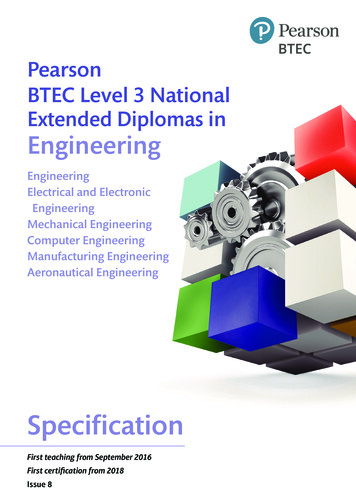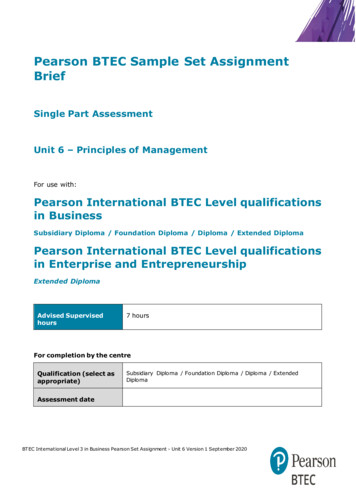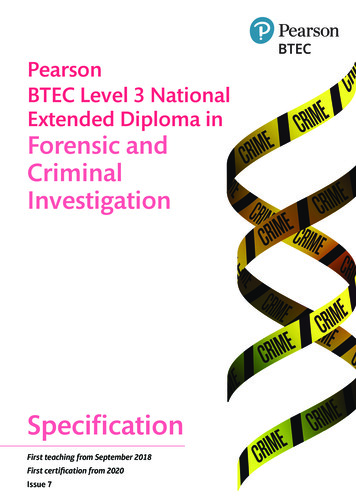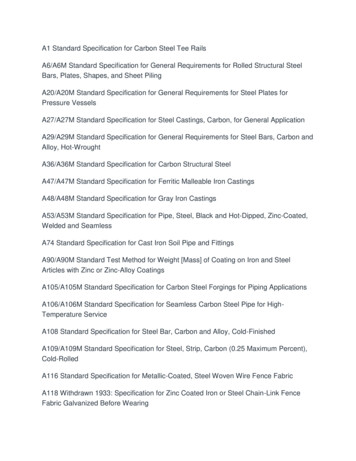
Transcription
PearsonBTEC Level 3 NationalExtended Diplomas inEngineeringEngineeringElectrical and ElectronicEngineeringMechanical EngineeringComputer EngineeringManufacturing EngineeringAeronautical EngineeringSpecificationFirst teaching from September 2016First certification from 2018Issue 8
PearsonBTEC Level 3 NationalExtended Diplomas inEngineeringEngineeringElectrical and ElectronicEngineeringMechanical EngineeringComputer EngineeringManufacturing EngineeringAeronautical EngineeringSpecificationFirst teaching September 2016Issue 8
Edexcel, BTEC and LCCI qualificationsEdexcel, BTEC and LCCI qualifications are awarded by Pearson, the UK’s largest awarding bodyoffering academic and vocational qualifications that are globally recognised and benchmarked.For further information, please visit our qualifications website at qualifications.pearson.com.Alternatively, you can get in touch with us using the details on our contact us page atqualifications.pearson.com/contactusAbout PearsonPearson is the world's leading learning company, with 25,000 employees in more than 70 countriesworking to help people of all ages to make measurable progress in their lives through learning.We put the learner at the centre of everything we do, because wherever learning flourishes, so dopeople. Find out more about how we can help you and your learners at qualifications.pearson.comThis specification is Issue 8. We will inform centres of any changes to this issue. The latest issuecan be found on our website.References to third-party material made in this specification are made in good faith. We do notendorse, approve or accept responsibility for the content of materials, which may be subject tochange, or any opinions expressed therein. (Material may include textbooks, journals, magazinesand other publications and websites.)ISBN 978 1 446 95114 9All the material in this publication is copyright Pearson Education Limited 2021
WelcomeWith a track record built over 30 years of learner success, BTEC Nationals are widely recognisedby industry and higher education as the signature vocational qualification at Level 3. They provideprogression to the workplace either directly or via study at a higher level. Proof comes fromYouGov research, which shows that 62% of large companies have recruited employees with BTECqualifications. What’s more, well over 100,000 BTEC students apply to UK universities every yearand their BTEC Nationals are accepted by over 150 UK universities and higher education institutesfor relevant degree programmes either on their own or in combination with A Levels.Why are BTECs so successful?BTECs embody a fundamentally learner-centred approach to the curriculum, with a flexible,unit-based structure and knowledge applied in project-based assessments. They focus on theholistic development of the practical, interpersonal and thinking skills required to be able tosucceed in employment and higher education.When creating the BTEC Nationals in this suite, we worked with many employers, higher educationproviders, colleges and schools to ensure that their needs are met. Employers are looking forrecruits with a thorough grounding in the latest industry requirements and work-ready skills suchas teamwork. Higher education needs students who have experience of research, extended writingand meeting deadlines.We have addressed these requirements with: a range of BTEC sizes, each with a clear purpose, so there is something to suit eachlearner’s choice of study programme and progression plans refreshed content that is closely aligned with employers’ and higher education needs for askilled future workforce assessments and projects chosen to help learners progress to the next stage. This meanssome are set by you to meet local needs, while others are set and marked by Pearsonso that there is a core of skills and understanding that is common to all learners. Forexample, a written test can be used to check that learners are confident in using technicalknowledge to carry out a certain job.We are providing a wealth of support, both resources and people, to ensure that learners and theirteachers have the best possible experience during their course. See Section 10 for details of thesupport we offer.A word to learnersToday’s BTEC Nationals are demanding, as you would expect of the most respected applied learningqualification in the UK. You will have to choose and complete a range of units, be organised, takesome assessments that we will set and mark, and keep a portfolio of your assignments. But youcan feel proud to achieve a BTEC because, whatever your plans in life – whether you decide tostudy further, go on to work or an apprenticeship, or set up your own business – your BTECNational will be your passport to success in the next stage of your life.Good luck, and we hope you enjoy your course.
Collaborative developmentStudents completing their BTEC Nationals in Engineering will be aiming to go on to employment,often via the stepping stone of higher education. It was, therefore, essential that we developedthese qualifications in close collaboration with experts from professional bodies, businesses anduniversities, and with the providers who will be delivering the qualifications. To ensure that thecontent meets providers’ needs and provides high-quality preparation for progression, we engagedexperts. We are very grateful to all the university and further education lecturers, teachers,employers, professional body representatives and other individuals who have generously sharedtheir time and expertise to help us develop these new qualifications.Employers, professional bodies and higher education providers that have worked with us include:Cisco SystemsEngineering CouncilNetwork RailNottingham Trent UniversityParafixRoyal Academy of EngineeringUniversity of ExeterUniversity of Northampton.These qualifications have been approved by the engineering professional bodies on behalf of theEngineering Council as contributing to the requirements for professional registration as anEngineering Technician (EngTech).The professional bodies include:The Institution of Engineering and Technology (IET)The Institution of Mechanical Engineers (IMechE)The Society of Operations Engineers (SOE).In addition, universities, professional bodies and businesses have provided letters of supportconfirming that these qualifications meet their entry requirements. These letters can be viewed onour website.
Summary of Pearson BTEC Level 3 National Extended Diplomas inEngineering Specification Issue 8 changesSummary of changes made between the previous issue and thiscurrent issuePagenumberThe last paragraph of the Qualification and unit content section has beenamended to allow centres delivering the qualification above to alter the contentto reflect the context of the country where it is being delivered.Page 14Changes made to Unit 16: Three Phase Electrical Systems Content andAssessment criteria for Learning aim C to replace ‘domestic’ with‘industrial/commercial’ and clarify the wording in criterion C.D3.Pages 211and 212Changes made to Unit 19: Electronic Devices and Circuits Content for B3,Assessment criteria for Learning aim B and Essential information for assessmentdecisions section Learning aim B Distinction and Merit standard.Pages 242,244, 247Changes made to Unit 54: Aircraft Electrical and Instrument Systems Assessmentcriteria and Essential information for assessment decisions for Learning aim C toreplace ‘assemble’ with ‘inspect’.Pages 643and 647A new unit Unit 57: Sustainable Transport has been added to the Pearson BTECLevel 3 National Extended Diploma in Engineering in this specification.Pages 13, 30and 669-676A new unit Unit 58: Energy Management has been added to the Person BTECLevel 3 National Extended Diploma in Engineering in this specification.Pages 13, 30and 677-685If you need further information on these changes or what they mean, contact us via our website s.html.
ContentsIntroduction to BTEC National qualifications for the engineering sectorTotal Qualification TimeQualifications, sizes and purposes at a glance123Structures of the qualifications at a glance10Qualification and unit content14Assessment14Grading for units and qualifications16UCAS Tariff points161 Qualification purpose172 Structure293 Units43Understanding your units43Index of units474 Planning your programme6875 Assessment structure and external assessment690Introduction690Internal assessment690External assessment6906 Internal assessment692Principles of internal assessment692Setting effective assignments694Making valid assessment decisions696Planning and record keeping6987 Administrative arrangements699Introduction699Learner registration and entry699Access to assessment699Administrative arrangements for internal assessment700Administrative arrangements for external assessment701Dealing with malpractice in assessment703Certification and results705Additional documents to support centre administration7058 Quality assurance7069 Understanding the qualification grade70810 Resources and support714Support for setting up your course and preparing to teach714Support for teaching and learning715Support for assessment715Training and support from Pearson716Appendix 1 Links to industry standards717Appendix 2 Glossary of terms used for internally-assessed units718
Introduction to BTEC National qualificationsfor the engineering sectorThis specification contains the information you need to deliver the Pearson BTEC Level 3 NationalExtended Diplomas in Engineering. The specification signposts you to additional handbooks andpolicies. It includes all the units for these qualifications.These qualifications are part of the suite of engineering qualifications offered by Pearson. In thesuite there are qualifications that focus on different progression routes, allowing learners to choosethe one best suited to their aspirations.All qualifications in the suite share some common units and assessments, allowing learners someflexibility in moving between qualifications where they wish to select a more specific progressionroute. The qualification titles are given below.Within this suite are BTEC National qualifications for post-16 learners wishing to specialise in aspecific industry, occupation or occupational group. The qualifications give learners specialistknowledge and technical skills, enabling entry to an Apprenticeship or other employment, orprogression to related higher education courses. Learners taking these qualifications must have asignificant level of employer involvement in their programmes.In the engineering sector these qualifications are:Pearson BTEC Level 3 National Diploma in Engineering (720 GLH) 601/7580/1Pearson BTEC Level 3 National Diploma in Electrical and Electronic Engineering (720 GLH)601/7579/5Pearson BTEC Level 3 National Diploma in Mechanical Engineering (720 GLH) 601/7583/7Pearson BTEC Level 3 National Diploma in Computer Engineering (720 GLH) 601/7578/3Pearson BTEC Level 3 National Diploma in Manufacturing Engineering (720 GLH) 601/7582/5Pearson BTEC Level 3 National Diploma in Aeronautical Engineering (720 GLH) 601/7577/1Pearson BTEC Level 3 National Extended Diploma in Engineering (1080 GLH) 601/7588/6Pearson BTEC Level 3 National Extended Diploma in Electrical and Electronic Engineering(1080 GLH) 601/7587/4Pearson BTEC Level 3 National Extended Diploma in Mechanical Engineering (1080 GLH)601/7590/4Pearson BTEC Level 3 National Extended Diploma in Computer Engineering (1080 GLH) 601/7586/2Pearson BTEC Level 3 National Extended Diploma in Manufacturing Engineering (1080 GLH)601/7589/8Pearson BTEC Level 3 National Extended Diploma in Aeronautical Engineering (1080 GLH)601/7585/0.Other BTEC National qualifications in this sector provide a broad introduction that gives learnerstransferable knowledge and skills. These qualifications are for post-16 learners who want tocontinue their education through applied learning. The qualifications prepare learners for a range ofhigher education courses either by meeting entry requirements in their own right or by beingaccepted alongside other qualifications at the same level and adding value to them. Learners mayprogress to one of the qualifications in this specification having completed a smaller qualificationthat provides suitable fundamental knowledge and skills.In the engineering sector these qualifications are:Pearson BTEC Level 3 National Certificate in Engineering (180 GLH) 603/1197/6Pearson BTEC Level 3 National Extended Certificate in Engineering (360 GLH) 601/7584/9Pearson BTEC Level 3 National Foundation Diploma in Engineering (540 GLH) 601/7591/6.This specification signposts all the other essential documents and support that you need as acentre in order to deliver, assess and administer the qualification, including the staff developmentrequired. A summary of all essential documents is given in Section 7. Information on how we cansupport you with these qualifications is given in Section 10.The information in this specification is correct at the time of publication.Pearson BTEC Level 3 National Extended Diplomas in Engineering –Specification – Issue 8 – May 2021 Pearson Education Limited 20211
Total Qualification TimeFor all regulated qualifications, Pearson specifies a total number of hours that it is estimatedlearners will require to complete and show achievement for the qualification: this is the TotalQualification Time (TQT). Within TQT, Pearson identifies the number of Guided Learning Hours(GLH) that we estimate a centre delivering the qualification might provide. Guided learning meansactivities, such as lessons, tutorials, online instruction, supervised study and giving feedback onperformance, that directly involve teachers and assessors in teaching, supervising and invigilatinglearners. Guided learning includes the time required for learners to complete external assessmentunder examination or supervised conditions.In addition to guided learning, other required learning directed by teachers or assessors will includeprivate study, preparation for assessment and undertaking assessment when not undersupervision, such as preparatory reading, revision and independent research.BTEC Nationals have been designed around the number of hours of guided learning expected. Eachunit in the qualification has a GLH value of 60, 90 or 120. There is then a total GLH value for thequalification.Each qualification has a TQT value. This may vary within sectors and across the suite depending onthe nature of the units in each qualification and the expected time for other required learning.The following table shows all the qualifications in this sector and their GLH and TQT values.2Pearson BTEC Level 3 National Extended Diplomas in Engineering –Specification – Issue 8 – May 2021 Pearson Education Limited 2021
Qualifications, sizes and purposes at a glanceTitleSize and structureSummary purposePearson BTEC Level 3National Certificate inEngineering180 GLH (260 TQT)This qualification is intended forpost-16 learners who want tocontinue their education throughapplied learning and who aim toprogress to higher education andultimately employment.Equivalent in size to 0.5 of anA Level.2 units of which both aremandatory and 1 is external.Mandatory content (100%).External assessment (67%).Pearson BTEC Level 3National ExtendedCertificate inEngineering360 GLH (465 TQT)Equivalent in size to one A Level.4 units of which 3 are mandatoryand 2 are external.Mandatory content (83%).External assessment (67%).Pearson BTEC Level 3National FoundationDiploma in Engineering540 GLH (740 TQT)Equivalent in size to 1.5 A Levels.7 units of which 4 are mandatoryand 2 are external.Mandatory content (67%).External assessment (44%).Pearson BTEC Level 3National Diploma inEngineering720 GLH (975 TQT)Equivalent in size to twoA Levels.10 units of which 5 are mandatoryand 2 are external.Mandatory content (58%).External assessment (33%).It aims to provide a coherentintroduction to study of theengineering sector.This qualification provides abroad basis of study for theengineering sector.It has been designed to supportprogression to higher educationwhen taken as part of aprogramme of study thatincludes other appropriateBTEC Nationals or A Levels.This qualification has beendesigned as a one-year,full-time course that supportsprogression to an apprenticeshipin engineering or to a furtheryear of study at Level 3. If takenas part of a programme of studythat includes other BTECNationals or A Levels, it supportsprogression to higher education.This qualification is aimed atlearners preparing for rolesin engineering, for exampleengineering technician orengineering operative.Learners gain relevant skillsand knowledge from studyinga range of content focusedon electrical/electronic andmechanical disciplines, forexample electrical machinesand maintenance of mechanicalsystems.The qualification has beendesigned to be the substantivepart of a 16–19 studyprogramme for learners whowant a strong core of sectorstudy and a focus on the widerengineering industry. It maybe complemented with otherBTEC Nationals or A Levels ornon-qualification elements tosupport progression to specificjob roles or to higher educationcourses in engineering.Pearson BTEC Level 3 National Extended Diplomas in Engineering –Specification – Issue 8 – May 2021 Pearson Education Limited 20213
TitleSize and structureSummary purposePearson BTEC Level 3National Diploma inElectrical and ElectronicEngineering720 GLH (980 TQT)This qualification is aimed atlearners preparing for rolesin electrical and electronicengineering, for exampleelectrical engineering technicianor electronic engineeringoperative. Learners gainrelevant skills and knowledgefrom studying a range of units,for example in electronic devicesand circuits, power and energysystems and printed circuitboard design and manufacture.Equivalent in size to twoA Levels.10 units of which 5 are mandatoryand 2 are external.Mandatory content (58%).External assessment (33%).The qualification is designed tobe the substantive part of a16–19 study programme forlearners wanting a strong coreof electrical and electronicengineering. It may becomplemented with otherBTEC Nationals or A Levels ornon-qualification elements tosupport progression to specificjob roles or to higher educationcourses in engineering.Pearson BTEC Level 3National Diploma inMechanical Engineering720 GLH (985 TQT)Equivalent in size to twoA Levels.10 units of which 5 are mandatoryand 2 are external.Mandatory content (58%).External assessment (33%).This qualification is aimed atlearners preparing for roles inmechanical engineering, forexample mechanical engineeringtechnician or mechanical fitter.Learners gain relevant skills andknowledge from studying arange of units, for example inmetallic and non-metallicmaterials, fluid mechanicsand/or thermodynamicpractices.The qualification is designedto be the substantive part ofa 16–19 study programme forlearners who want a strong coreof mechanical engineering.The qualification may becomplemented with otherBTEC Nationals or A Levels ornon-qualification elements tosupport progression to specificjob roles or to higher educationcourses in engineering.4Pearson BTEC Level 3 National Extended Diplomas in Engineering –Specification – Issue 8 – May 2021 Pearson Education Limited 2021
TitleSize and structureSummary purposePearson BTEC Level 3National Diploma inComputer Engineering720 GLH (985 TQT)This qualification is aimed atlearners preparing for rolesin computer engineering, forexample computer engineeringtechnician or computer supportanalyst. Learners gain relevantskills and knowledge fromstudying a range of units,for example in computerprogramming, website designand/or cyber security.Equivalent in size to twoA Levels.10 units of which 6 are mandatoryand 2 are external.Mandatory content (67%).External assessment (33%).The qualification is designedto be the substantive part ofa 16–19 study programme forlearners who want a strong coreof knowledge in computerengineering. It may becomplemented with otherBTEC Nationals or A Levels ornon-qualification elements tosupport progression to specificjob roles or to higher educationcourses in engineering.Pearson BTEC Level 3National Diploma inManufacturingEngineering720 GLH (980 TQT)Equivalent in size to twoA Levels.10 units of which 6 are mandatoryand 2 are external.Mandatory content (67%).External assessment (33%).This qualification is aimed atlearners preparing for roles inmanufacturing engineering,for example manufacturingengineering technician orwelding operative. Learners gainrelevant skills and knowledgefrom studying a range of units,for example in computer-aidedmanufacturing, modernmanufacturing systems, additivemanufacturing and machining.The qualification is designedto be the substantive part ofa 16–19 study programme forlearners who want a strong coreof knowledge of manufacturingengineering. It may becomplemented with otherBTEC Nationals or A Levels ornon-qualification elements tosupport progression to specificjob roles or to higher educationcourses in engineering.Pearson BTEC Level 3 National Extended Diplomas in Engineering –Specification – Issue 8 – May 2021 Pearson Education Limited 20215
TitleSize and structureSummary purposePearson BTEC Level 3National Diploma inAeronauticalEngineering720 GLH (990 TQT)This qualification is aimed atlearners preparing for rolesin aeronautical engineering,for example aeronauticalengineering technician oraerospace fitter. Learners gainrelevant skills and knowledgefrom studying a range of units,for example in aircraft workshopprinciples, gas turbine engines,airframe construction and firstline maintenance.Equivalent in size to twoA Levels.10 units of which 6 are mandatoryand 2 are external.Mandatory content (67%).External assessment (33%).The qualification is designedto be the substantive part ofa 16–19 study programme forlearners who want to focus onthe specific aspects that relateto the aeronautical industry.It may be complemented withother BTEC Nationals or A Levelsor non-qualification elements tosupport progression to specificjob roles or to higher educationcourses in engineering.Pearson BTEC Level 3National ExtendedDiploma in Engineering1080 GLH (1475 TQT)Equivalent in size to threeA Levels.15 units of which 7 are mandatoryand 3 are external.Mandatory content (56%).External assessment (33%).This qualification has beendesigned as a two-year,full-time course that meetsentry requirements in its ownright for learners wanting toprogress to employment inengineering. Learners gainrelevant skills and knowledgefrom studying a range of contentfocused on electrical/electronicand mechanical disciplines, forexample electrical machines andmaintenance of mechanicalsystems.Progression could be eitherdirectly to employment inLevel 3 job roles, higherapprenticeship programmesor via higher education coursesin engineering.6Pearson BTEC Level 3 National Extended Diplomas in Engineering –Specification – Issue 8 – May 2021 Pearson Education Limited 2021
TitleSize and structureSummary purposePearson BTEC Level 3National ExtendedDiploma in Electricaland ElectronicEngineering1080 GLH (1485 TQT)This qualification has beendesigned as a two-year,full-time course that meets entryrequirements in its own right forlearners wanting to progress toemployment in electrical andelectronic engineering, such asa power engineering technician.Learners gain relevant skillsand knowledge from studyinga range of units, for example inelectronic devices and circuits,power and energy systems,printed circuit board design andmanufacture, microcontrollersand/or calculus.Equivalent in size to threeA Levels.15 units of which 7 are mandatoryand 3 are external.Mandatory content (56%).External assessment (33%).Progression could be eitherdirectly to employment inLevel 3 job roles, higherapprenticeship programmesor via higher education coursesin engineering.Pearson BTEC Level 3National ExtendedDiploma in MechanicalEngineering1080 GLH (1485 TQT)Equivalent in size to threeA Levels.15 units of which 7 are mandatoryand 3 are external.Mandatory content (56%).External assessment (33%).This qualification has beendesigned as a two-year,full-time course that meets entryrequirements in its own right forlearners who want to progressto employment in mechanicalengineering, such as amechanical maintenancetechnician. Learners gainrelevant skills and knowledgefrom studying a range of units,for example in metallic andnon-metallic materials, fluidmechanics, thermodynamicpractices, microcontrollersand/or calculus.Progression could be eitherdirectly to employment inLevel 3 job roles, higherapprenticeship programmesor via higher education coursesin engineering.Pearson BTEC Level 3 National Extended Diplomas in Engineering –Specification – Issue 8 – May 2021 Pearson Education Limited 20217
TitleSize and structureSummary purposePearson BTEC Level 3National ExtendedDiploma in ComputerEngineering1080 GLH (1485 TQT)This qualification has beendesigned as a two-year,full-time course that meetsentry requirements in its ownright for learners wanting toprogress to employment incomputer engineering, such asa computer support technician.Learners gain relevant skillsand knowledge from studyinga range of units, for examplein computer programming,microcontrollers, website design,cyber security, microcontrollersand/or calculus.Equivalent in size to threeA Levels.15 units of which 8 are mandatoryand 3 are external.Mandatory content (61%).External assessment (33%).Progression could be eitherdirectly to employment inLevel 3 job roles, higherapprenticeship programmesor via higher education coursesin engineering.Pearson BTEC Level 3National ExtendedDiploma inManufacturingEngineering1080 GLH (1475 TQT)Equivalent in size to threeA Levels.15 units of which 8 are mandatoryand 3 are external.Mandatory content (61%).External assessment (33%).This qualification has beendesigned as a two-year,full-time course that meets entryrequirements in its own right forlearners wanting to progress toemployment in manufacturingengineering, such as a qualitycontrol technician. Learners gainrelevant skills and knowledgefrom studying a range of units,for example in computer-aidedmanufacturing, modernmanufacturing systems,microcontrollers, additivemanufacturing, and machining.Progression could be eitherdirectly to employment inLevel 3 job roles, higherapprenticeship programmesor via higher education coursesin engineering.8Pearson BTEC Level 3 National Extended Diplomas in Engineering –Specification – Issue 8 – May 2021 Pearson Education Limited 2021
TitleSize and structureSummary purposePearson BTEC Level 3National ExtendedDiploma in AeronauticalEngineering1080 GLH (1495 TQT)This qualification has beendesigned as a two-year,full-time course that meets entryrequirements in its own right forlearners wanting to progress toemployment in aeronautical/aerospace engineering, forexample in aerospacemanufacturing or as a systemsfitter or aircraft maintenanceoperative. Learners gain relevantskills and knowledge fromstudying a range of units, forexample in aircraft workshopprinciples, microcontrollers,calculus, gas turbine engines,airframe construction andfirst-line maintenance.Equivalent in size to threeA Levels.15 units of which 8 are mandatoryand 3 are external.Mandatory content (61%).External assessment (33%).Progression could be eitherdirectly to employment inLevel 3 job roles, higherapprenticeship programmesor via higher education coursesin engineering.Pearson BTEC Level 3 National Extended Diplomas in Engineering –Specification – Issue 8 – May 2021 Pearson Education Limited 20219
Structures of the qualifications at a glanceThis table shows all the units and the qualifications to which they contribute. The full structure for this Pearson BTEC Level 3 National in Engineering isshown in Section 2. You must refer to the full structure to select units and plan your programme.KeyEMAUnit assessed externallyMMandatory ngAEAeronauticalUnit (number and title)OOptional dedCertificateFoundationDiplomaDiplomaExtended Diploma(GLH)(180 GLH)(360 GLH)(540 GLH)(720 GLH)(1080 MMMM1Engineering Principles2Delivery of EngineeringProcesses Safely as a Team3Engineering Product Design andManufacture1204Applied Commercial and QualityPrinciples in Engineering605A Specialist Engineering Project606Microcontroller Systems forEngineers7Calculus to Solve EngineeringProblems608Further Engineering Mathematics609Work Experience in theEngineering Sector60O10 Computer Aided Design inEngineering6011 Engineering Maintenance andCondition Monitoring Techniques12 Pneumatic and ontinued overleaf10Pearson BTEC Level 3 National Extended Diplomas in Engineering –Specification – Issue 8 – May 2021 Pearson Education Limited 2021
Unit (number and tionDiploma(GLH)(180 GLH)(360 GLH)(540 GLH)Diploma(720 GLH)E13 Welding Technology6014 Electrical Installation ofHardware and Cables6015 Electrical Machines6016 Three Phase Electrical SystemsOExtended DiplomaEEOMECO(1080 GLH)MAAEEOOOOOOO60OO17 Power and Energy Electronics60OO18 Electrical Power Distribution andTransmission60OO19 Electronic Devices and Circuits60OOOO20 Analogue Electronic Circuits60OOO21 Electronic Measurement andTesting of Circuits60OOOO22 Electronic Printed Circuit BoardDesign and Manufacture60OOO23 Digital and Analogue ElectronicSystems60OO24 Maintenance of MechanicalSystems60OOOOOO25 Mechanical Behaviour of MetallicMaterials60OOOOOO26 Mechanical Behaviour of Nonmetallic Materials60O27 St
Welcome With a track record built over 30 years of learner success, BTEC Nationals are widely recognised by industry and higher education as the signature vocational qualification at Level 3.










